光电子学与光子学讲义-作业答案(第1、2章)13版.doc
光电子技术基础与应用习题答案
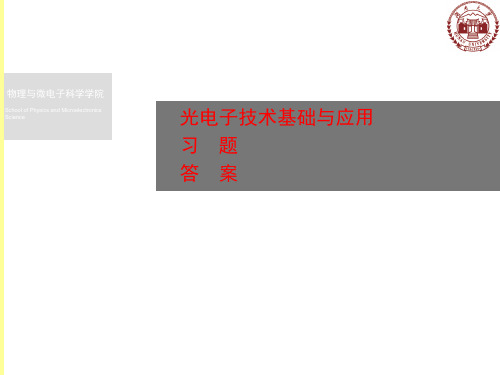
第三章 习题(1)
1. 填空
① 最早的电光源是
,最早的激光器是 年由 国的 制作的 。
② 光在各向同性介质中传播时,复极化率的实部表示 虚部表示 与频率的关系。
与频率的关系,
③ 激光器的基本结构包括 、 是 、 ,必要条件包括
、 。激光产生的充分条件
、
。
④ 今有一个球面激光腔r1=1.5m,r2=-1m,L=80cm,它属于 2. 试简单说明以下光电子学术语的科学含义:
8. 从麦克斯韦通式(2-28)出发,推导波动方程(2-44)。
1. 填空题:
第二章 习题答案(1)
第二章 习题答案(2)
第二章 习题答案(3)
6. 输出波长为=632.8nm的He-Ne激光器中的反射镜是在玻璃上交替涂覆ZnS和 ThF2形成的,这两种材料的折射率系数分别为1.5和2.5。问至少涂覆多少个双层 才能使镜面反射系数大于99.5%?
第三章复习思考题(8)
4. 简述题 (5)以一个三能级原子系统为例, 说明激光器的基本组成和产生激光的基本原理。
4. 简述题
第三章复习思考题(9)
4. 简述题 (7)分析激光产生的条件。
第三章复习思考题(10)
4. 简述题 (7)分析激光产生的条件。
第三章复习思考题(11)
4. 简述题
第三章复习思考题(12)
讲授内容
第三、四、五讲
1 第一章 绪 论(一讲) 2 第二章 光学基础知识与光场传播规律(二讲)
3 第三章 激光原理与技术(三、四、五讲)
4 第四章 光波导技术基础(六、七讲) 5 第五章 光调制技术—光信息系统的信号加载与控制(八、九、十讲)
6 第六章 光电探测技术(十一、十二讲)
光电子课后习题答案
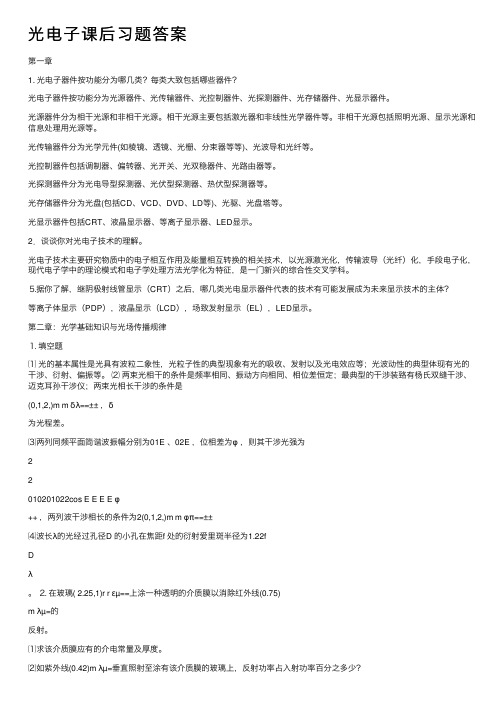
光电⼦课后习题答案第⼀章1. 光电⼦器件按功能分为哪⼏类?每类⼤致包括哪些器件?光电⼦器件按功能分为光源器件、光传输器件、光控制器件、光探测器件、光存储器件、光显⽰器件。
光源器件分为相⼲光源和⾮相⼲光源。
相⼲光源主要包括激光器和⾮线性光学器件等。
⾮相⼲光源包括照明光源、显⽰光源和信息处理⽤光源等。
光传输器件分为光学元件(如棱镜、透镜、光栅、分束器等等)、光波导和光纤等。
光控制器件包括调制器、偏转器、光开关、光双稳器件、光路由器等。
光探测器件分为光电导型探测器、光伏型探测器、热伏型探测器等。
光存储器件分为光盘(包括CD、VCD、DVD、LD等)、光驱、光盘塔等。
光显⽰器件包括CRT、液晶显⽰器、等离⼦显⽰器、LED显⽰。
2.谈谈你对光电⼦技术的理解。
光电⼦技术主要研究物质中的电⼦相互作⽤及能量相互转换的相关技术,以光源激光化,传输波导(光纤)化,⼿段电⼦化,现代电⼦学中的理论模式和电⼦学处理⽅法光学化为特征,是⼀门新兴的综合性交叉学科。
⒌据你了解,继阴极射线管显⽰(CRT)之后,哪⼏类光电显⽰器件代表的技术有可能发展成为未来显⽰技术的主体?等离⼦体显⽰(PDP),液晶显⽰(LCD),场致发射显⽰(EL),LED显⽰。
第⼆章:光学基础知识与光场传播规律⒈填空题⑴光的基本属性是光具有波粒⼆象性,光粒⼦性的典型现象有光的吸收、发射以及光电效应等;光波动性的典型体现有光的⼲涉、衍射、偏振等。
⑵两束光相⼲的条件是频率相同、振动⽅向相同、相位差恒定;最典型的⼲涉装臵有杨⽒双缝⼲涉、迈克⽿孙⼲涉仪;两束光相长⼲涉的条件是(0,1,2,)m m δλ==±± ,δ为光程差。
⑶两列同频平⾯简谐波振幅分别为01E 、02E ,位相差为φ,则其⼲涉光强为22010201022cos E E E E φ++ ,两列波⼲涉相长的条件为2(0,1,2,)m m φπ==±±⑷波长λ的光经过孔径D 的⼩孔在焦距f 处的衍射爱⾥斑半径为1.22fDλ。
(完整word版)《光电子技术》章节练习题及答案
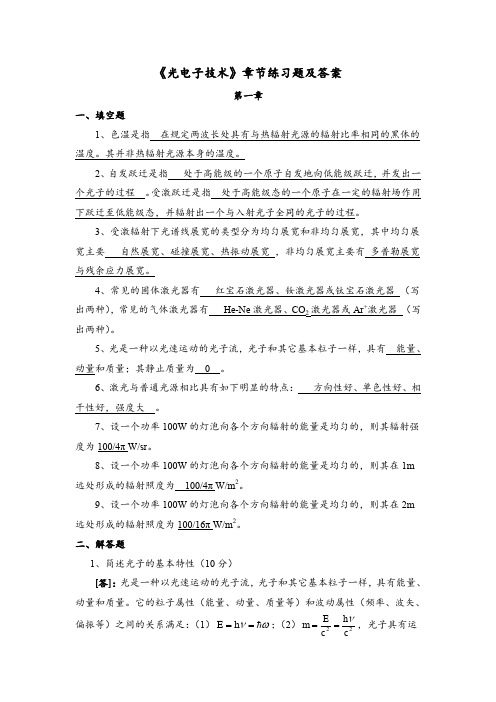
《光电子技术》章节练习题及答案第一章一、填空题1、色温是指 在规定两波长处具有与热辐射光源的辐射比率相同的黑体的温度。
其并非热辐射光源本身的温度。
2、自发跃迁是指 处于高能级的一个原子自发地向低能级跃迁,并发出一个光子的过程 。
受激跃迁是指 处于高能级态的一个原子在一定的辐射场作用下跃迁至低能级态,并辐射出一个与入射光子全同的光子的过程。
3、受激辐射下光谱线展宽的类型分为均匀展宽和非均匀展宽,其中均匀展宽主要 自然展宽、碰撞展宽、热振动展宽 ,非均匀展宽主要有 多普勒展宽与残余应力展宽。
4、常见的固体激光器有 红宝石激光器、钕激光器或钛宝石激光器 (写出两种),常见的气体激光器有 He-Ne 激光器、CO 2激光器或Ar +激光器 (写出两种)。
5、光是一种以光速运动的光子流,光子和其它基本粒子一样,具有 能量、动量和质量;其静止质量为 0 。
6、激光与普通光源相比具有如下明显的特点: 方向性好、单色性好、相干性好,强度大 。
7、设一个功率100W 的灯泡向各个方向辐射的能量是均匀的,则其辐射强度为100/4π W/sr 。
8、设一个功率100W 的灯泡向各个方向辐射的能量是均匀的,则其在1m 远处形成的辐射照度为 100/4π W/m 2。
9、设一个功率100W 的灯泡向各个方向辐射的能量是均匀的,则其在2m 远处形成的辐射照度为100/16π W/m 2。
二、解答题1、简述光子的基本特性(10分)[答]:光是一种以光速运动的光子流,光子和其它基本粒子一样,具有能量、动量和质量。
它的粒子属性(能量、动量、质量等)和波动属性(频率、波矢、偏振等)之间的关系满足:(1)ων ==h E ;(2)22ch c E m ν==,光子具有运动质量,但静止质量为零;(3) k P =;(4)、光子具有两种可能的独立偏振态,对应于光波场的两个独立偏振方向;(5)、光子具有自旋,并且自旋量子数为整数,是玻色子。
光电子作业答案

光电子作业答案第一章1-2辐射量与光度量的根本区别是什么?答:辐射量是物理学中对电磁辐射测量的方法来描述光辐射的一套参量是客观物理量光度量则是以人的视觉为基础,对光辐射进行测量的科学,所以光度量主要体现了人眼的视觉特性。
1-8激光有哪些特点?激光器有哪三部分组成,每部分的主要作用?答:(1)激光特点:高亮度,高方向性,高单色性和高度的时间空间相干性(2)激光器的组成:工作物质,光学谐振腔,泵浦源。
(3)作用:工作物质是提供形成激光的能级结构体系,是激光产生的内因;光学谐振腔是提供反馈放大结构使受激辐射的方向性单色性提高;泵浦源是提供形成激光的能量激励,是激光形成的外因1-9是叙述半导体发光二极管和半导体激光器在结构上和发光机理上的差异?答:两者都是由半导体PN结构成的,对PN结正向注入电流,电子与空穴复合发光。
区别:LED没有谐振腔,它的发光基子自发辐射,发出的荧光是非相干光,LD的发光基于受激辐射,发出的是相干光----激光,LED的体积小,结构简单,耗电少,寿命长,造价低,应用广泛。
1-11为什么二能级系统不能产生激光?答:因为B12=B21=B => 吸收速率和受激辐射速率相等所以W12=W21=W令E1,E2能级上单位体积内的原子数分别是n1,n2 所以dn2/dt=w(n1-n2)-n1A21 令dn2/dt=0(稳定时) 所以n2/n1=w/(A2+w) 由式看到无论泵浦源怎样A21+w总是大于w即n2总小于n1只有当w十分大时n2/n1才近似等于1,所以不能发生粒子数反转及而能级系统不能产生激光。
三能级要实现粒子数反转必须把基态上一半以上的粒子抽运到亚稳态,这个需要很大外力作用很难实现。
1-12分析四能级和三能级激光器相比所具有的优点。
答:三能级中粒子数反转在E2和E1之间,由E2能级作为亚稳态,基态能级上聚集大量粒子,要实现n1<n2.外界抽运后相当难。
四能级粒子数反转是在E2和E1之间,下能级是E2,并不像E1上会聚大量粒子相反地,E2能级上的粒子数很少,很容易实现粒子数反转节省了能量。
光电子学课后习题chapter2&3
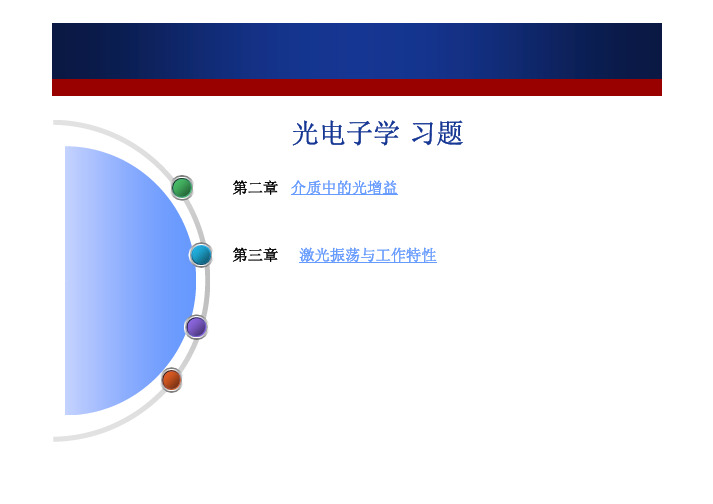
(3-1-5) lc = c ∆ν
故:光源频率宽度越窄,相干时间越长,相干长度 也越长。
Ac ≈
λ 2 R2
∆As
(3-1-12)
相干面积:面积为AS的光源辐射出波长为λ的光波, 通过与光源相距为R且垂直于光的传播方向上的平 面两点,如果这两点位于Ac内,这两点的光场相 关,可产生干涉效应。
λ 2 R2 c i Vc = Ac lc = ∆As ∆ν
(3-1-13)
相干体积:在单位面积光源辐射出的单位频率宽度的 光波,在其传播方向上可产生干涉效应的范围。
3.谐振腔里两个反射镜的曲率半径份别为40cm,80cm, 求实现稳定腔工作时,腔长的取值范围。 解: R1=40cm>0,R2=80cm>0
2.一光束入射到长为10CM,增益系数为0.5CM-1的工作 物质中,求出射光强对入射光强的比值。 解: 利用增益系数的公式
1 I ( x) G = ln x I0
( 2 − 2 − 3)
Gx
⇒ I ( x) = I 0 e
I ( x = 10) Gx 0.5×10 5 =e =e = e ≈ 148 I0
⎛ L ⎞⎛ L⎞ ∵ 0 < g1 g 2 = ⎜1 − ⎟⎜ 1 − ⎟ < 1 ⎝ R1 ⎠⎝ R2 ⎠
( R1 − L)( R2 − L) <1 R1 R2 ∵ R1 R2 > 0 ∴ ( R1 − L)( R2 − L) < R1 R2
⇒ L2 -(R1 +R2) 0 L < L ⋅ [ L-(R1 +R2 )] < 0 ∵L > 0 ∴ L < R1 +R2
− LG
(整理)光电子习题答案
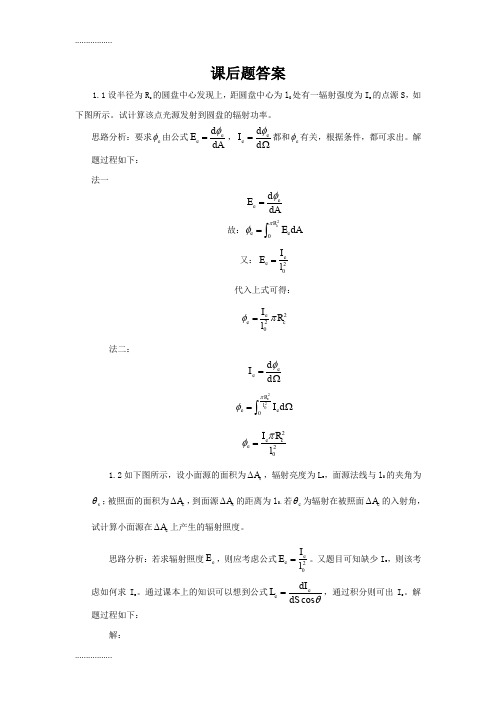
课后题答案1.1设半径为R c 的圆盘中心发现上,距圆盘中心为l 0处有一辐射强度为I e 的点源S ,如下图所示。
试计算该点光源发射到圆盘的辐射功率。
思路分析:要求e φ由公式e e d E dA φ=,ee d I d φ=Ω都和e φ有关,根据条件,都可求出。
解题过程如下: 法一ee d E dAφ=故:20cR e e E dA πφ=⎰又:20ee I E l =代入上式可得:220e e c I R l φπ=法二:ee d I d φ=Ω220c R l e e Id πφ=Ω⎰220e c e I R l πφ=1.2如下图所示,设小面源的面积为s A ∆,辐射亮度为L e ,面源法线与l 0的夹角为s θ;被照面的面积为c A ∆,到面源s A ∆的距离为l 0。
若c θ为辐射在被照面c A ∆的入射角,试计算小面源在c A ∆上产生的辐射照度。
思路分析:若求辐射照度e E ,则应考虑公式20ee I E l =。
又题目可知缺少I e ,则该考虑如何求I e 。
通过课本上的知识可以想到公式cos ee dI L dS θ=,通过积分则可出I e 。
解题过程如下:解:20ee I E l =由cos ee dI L dS θ=可得cos sA e e I L dS θ∆=⎰= cos e s L A θ∆,故:2200cos e e se I L A E l l θ∆== 1.3假如有一个按朗伯余弦定律发射辐射的大扩展源(如红外装置面对的天空背景),其各处的辐射亮度L e 均相同。
试计算该扩展源在面积为A d 的探测器表面上产生的辐射照度。
思路分析:题目中明确给出扩展源是按朗伯余弦定律发射辐射的,且要求辐射照度E e ,由公式ee d E dAφ=可知,要解此题需求出e d φ,而朗伯体的辐射通量为cos e e e d L dS d L dS φθπ=Ω=⎰,此题可解。
解题过程如下:解:ee d E dAφ=cos e e e d L dS d L dS φθπ=Ω=⎰e e e L dSE L dAππ== 1.4霓虹灯发的光是热辐射吗?答:霓虹灯发光是以原子辐射产生的光辐射,属于气体放电,放电原理后面章节会涉及到。
光电子学教程_课后作业答案

好好学习,天天上上
03电子科学与技术
2. 说明相干长度相干时间与光源的关系:相干面积,相干体积的 物理意义。 答:根据
lc c c , c 1 1 c c , lc
故:光源频率宽度 越窄,相干时间越长,相干长度也越长。 根据P49(3-1-12),相干面积的物理意义:从单位面积光源辐射出的 光波,在其传播方向上发生相干现象的任一截面面积范围为辐 射波长λ与该截面至光源距离R的乘积的平方。
好好学习,天天上上
9. 经典物理观点:跃迁所发出的电磁波不是单色波,而是分 布在中心频率附近的一个小的频率范围的单色波的组合, 在谱图上正好表现为一定宽度。 量子力学观点:由测不准关系,在某一时刻,粒子所处的 能级也是不确定的,即能级不是单一的,跃迁的结果也就 相当发出了多种不同频率的光子,形成了谱线宽度。自发 辐射过程中这种增宽效益是不可避免的,也是谱线宽度所 能达到的最低值,因而决不存在线宽为0的情况,即不可 能发出绝对的单色光。 由此可见,没有绝对单一波长的光波存在。
1好好学习天天上上03电子科学与技术光电子学课程作业光电子学课程作业参考用标准答案参考用标准答案202162203电子科学与技术章节目录第五章第五章光辐射的探测光辐射的探测第四章第四章光辐射在介质中波导中的传播光辐射在介质中波导中的传播第三章第三章激光振荡与工作特性激光振荡与工作特性第二章第二章介质中的光增益介质中的光增益第一章第一章光与物质相互作用基础光与物质相互作用基础第六章第六章发光器件发光器件第七章第七章光电转换器件光电转换器件第八章第八章第八章第八章光波调制光波调制03电子科学与技术电子科学与技术companylogo好好学习天天
1 I ( x) G ln x I0
1 1 ln 2 ln 8 5 x
光电子习题及答案

光电子习题及答案光电子习题及答案光电子学是研究光与电子相互作用的学科,它广泛应用于光电器件、光通信、光储存等领域。
在学习光电子学的过程中,习题是检验自己理解和掌握程度的重要方式。
下面,我们来讨论一些光电子学的习题及其答案。
1. 什么是光电效应?它与光子和电子之间的相互作用有什么关系?光电效应是指当光照射到金属或半导体表面时,会引起电子的发射现象。
光电效应的基本过程是光子与金属或半导体中的电子相互作用,使得电子获得足够的能量从而逃逸出材料表面。
光电效应的关键在于光子的能量必须大于或等于材料中电子的逸出功,才能引起电子的发射。
2. 什么是光电子倍增管?它的工作原理是什么?光电子倍增管是一种利用光电效应和二次发射效应来放大光信号的器件。
它由光阴极、倍增极、收集极和阳极组成。
当光照射到光阴极上时,光子与光阴极表面的电子发生光电效应,产生光电子。
这些光电子经过倍增极的二次发射作用,使得光电子的数量增加。
最后,这些光电子被收集极吸收,产生电流信号,经过放大后输出到阳极。
3. 什么是光电二极管?它与普通二极管有什么不同?光电二极管是一种利用光电效应来转换光信号为电信号的器件。
它由光阴极、势阻极和阳极组成。
当光照射到光阴极上时,光子与光阴极表面的电子发生光电效应,产生光电子。
这些光电子经过势阻极的势垒层,产生电流信号,经过放大后输出到阳极。
与普通二极管相比,光电二极管对光信号更加敏感,能够将微弱的光信号转换为电信号。
4. 什么是光通信?它的优势和应用领域有哪些?光通信是利用光信号传输信息的通信方式。
它通过光纤或自由空间传输光信号,具有大带宽、低损耗、抗干扰等优势。
光通信广泛应用于电话、互联网、电视等领域。
在长距离通信中,光通信可以实现高速、大容量的数据传输,满足现代社会对通信带宽的需求。
此外,光通信还被用于军事通信、卫星通信等领域。
5. 什么是光储存?它的原理和应用有哪些?光储存是利用光信号存储和读取信息的技术。
光电子学与光子学的原理及应用第二章-课后答案

光电子学与光子学的原理及应用第二章-课后答案1. 选择题1.1 题目一答案:C解析:光电效应是指物质受到光的照射后,吸收光能,将光能转化为电能的一种现象。
光电效应首先是由爱因斯坦在1905年提出的,他在描述光电效应时,引入了光子概念,假设光是由一组个别粒子组成的(即光量子),这些粒子就是后来被称为光子的电磁辐射量子。
1.2 题目二答案:A解析:光电倍增管是指通过光电效应,在光电面上光电发射物质外壳的钨丝和灯管之间加一个高达2000-3000伏的电压使其产生光电流,再对光电流进行电子倍增,最后输出检测的一种光电探测器。
光电倍增管的结构与普通的电子管相似,但是在各个电极和玻璃壳之间加入了紧密和高度真空的保护,同时在阳极和阳极网之间还添加了一个用直流电压加电的光电体。
当阳极对外加正电压使阳极电流开始增大时,就成为光电倍增管。
1.3 题目三答案:D解析:光电二极管是一种能够将光信号转化为电信号的器件。
光电二极管的基本原理是利用半导体材料的PN结在光照射下产生光电效应,使得PN结两端产生电荷,从而产生电压信号。
光电二极管的结构和普通二极管类似,主要由P型和N型的半导体材料组成,当光照射到光电二极管上时,光子能量被半导体材料所吸收,产生的热力激发电子,从而引起半导体PN结的载流子的复合和流动,产生感光电流。
光电二极管应用广泛,如光通信、光电测量、光谱分析等领域。
1.4 题目四答案:B解析:光导纤维是一种能够传输光信号的特殊纤维材料。
光导纤维的核心部分是由高折射率的材料构成,而外部由低折射率的材料构成。
当光线传输到光导纤维中时,会发生全反射现象,使得光线能够沿着光导纤维进行传输,最终到达目标地点。
光导纤维具有传输距离远、损耗小、带宽大、抗电磁干扰等优点,在通信、医疗、传感等领域得到广泛应用。
2. 填空题2.1 题目一答案:钠解析:钠具有低电离电势,激发电子的能量比较低,是光电电子极容易脱离的材料之一。
2.2 题目二答案:光电效应解析:光电效应是指物质受到光的照射后,吸收光能,将光能转化为电能的一种现象。
光电子学与光子学讲义-作业答案(第1、2章)13版.doc
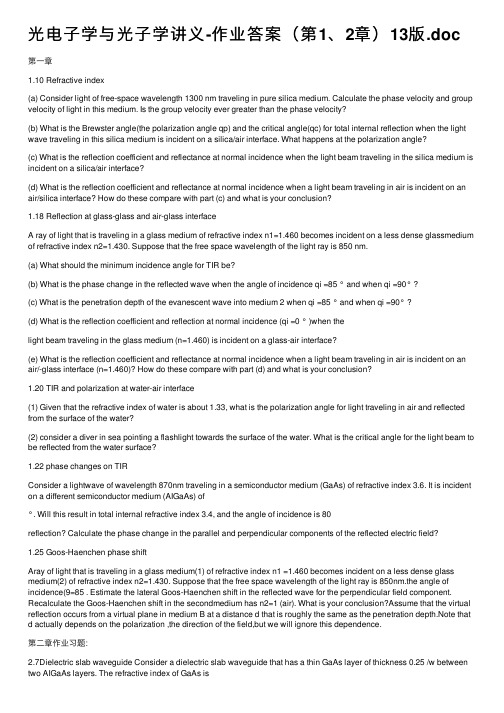
光电⼦学与光⼦学讲义-作业答案(第1、2章)13版.doc 第⼀章1.10 Refractive index(a) Consider light of free-space wavelength 1300 nm traveling in pure silica medium. Calculate the phase velocity and group velocity of light in this medium. Is the group velocity ever greater than the phase velocity?(b) What is the Brewster angle(the polarization angle qp) and the critical angle(qc) for total internal reflection when the light wave traveling in this silica medium is incident on a silica/air interface. What happens at the polarization angle?(c) What is the reflection coefficient and reflectance at normal incidence when the light beam traveling in the silica medium is incident on a silica/air interface?(d) What is the reflection coefficient and reflectance at normal incidence when a light beam traveling in air is incident on an air/silica interface? How do these compare with part (c) and what is your conclusion?1.18 Reflection at glass-glass and air-glass interfaceA ray of light that is traveling in a glass medium of refractive index n1=1.460 becomes incident on a less dense glassmedium of refractive index n2=1.430. Suppose that the free space wavelength of the light ray is 850 nm.(a) What should the minimum incidence angle for TIR be?(b) What is the phase change in the reflected wave when the angle of incidence qi =85 ° and when qi =90° ?(c) What is the penetration depth of the evanescent wave into medium 2 when qi =85 ° and when qi =90° ?(d) What is the reflection coefficient and reflection at normal incidence (qi =0 ° )when thelight beam traveling in the glass medium (n=1.460) is incident on a glass-air interface?(e) What is the reflection coefficient and reflectance at normal incidence when a light beam traveling in air is incident on an air/-glass interface (n=1.460)? How do these compare with part (d) and what is your conclusion?1.20 TIR and polarization at water-air interface(1) Given that the refractive index of water is about 1.33, what is the polarization angle for light traveling in air and reflected from the surface of the water?(2) consider a diver in sea pointing a flashlight towards the surface of the water. What is the critical angle for the light beam to be reflected from the water surface?1.22 phase changes on TIRConsider a lightwave of wavelength 870nm traveling in a semiconductor medium (GaAs) of refractive index 3.6. It is incident on a different semiconductor medium (AIGaAs) of°. Will this result in total internal refractive index 3.4, and the angle of incidence is 80reflection? Calculate the phase change in the parallel and perpendicular components of the reflected electric field?1.25 Goos-Haenchen phase shiftAray of light that is traveling in a glass medium(1) of refractive index n1 =1.460 becomes incident on a less dense glass medium(2) of refractive index n2=1.430. Suppose that the free space wavelength of the light ray is 850nm.the angle of incidence(9=85 . Estimate the lateral Goos-Haenchen shift in the reflected wave for the perpendicular field component. Recalculate the Goos-Haenchen shift in the secondmedium has n2=1 (air). What is your conclusion?Assume that the virtual reflection occurs from a virtual plane in medium B at a distance d that is roughly the same as the penetration depth.Note that d actually depends on the polarization ,the direction of the field,but we will ignore this dependence.第⼆章作业习题:2.7Dielectric slab waveguide Consider a dielectric slab waveguide that has a thin GaAs layer of thickness 0.25 /w between two AIGaAs layers. The refractive index of GaAs is3.6 and that of the AIGaAs layers is 3.40. What is the cut-off wavelength beyond which only a single mode can propagate in the waveguide, assuming that the refractive index does not vary greatly with thewavelength? If a radiation of wavelength 860 nm (corresponding to bandgap radiation) is propagating in the GaAs layer, what is the penetration of the evanescent wave into the AIGaAs layer? What is the mode field width (MFW) of this radiation? Point out the effect of change of radiation wavelength (为on the MFW.2.9 Dielectric slab waveguide Consider a planar dielectric waveguide with a core thickness 10/m,ni=1.4446, n2=1.4440. Calculate the V -number, the mode angle 劣for m=0 (use a graphical solution, if necessary), penetration depth, and mode field distance (MFW=2 c(^2 9, for light wavelengths of 1.0 /xn and 5 /jn. What is your conclusion? Compare your MFW calculationwith 2?o =2a (V +1 )/V .The model angle 3is given as &=88.85?for ^=1 /m and ^=88.72 ?for ^=1.5 仰for the fundamental mode m=0.2.10 A multimode fibe r Consider a multimode fiber with a core diameter of 60 /m, core refractive index of 1.47, and a cladding refractive index of 1.45 both at 870 nm. Consider operating this fiber at ^=870nm.(e) Calculate the numerical aperture.(f) Find out the normalized core-cladding index difference.(g) Calculate the V-number for the fiber and estimate the number of guided modes.(h) Calculate the wavelength beyond which the fiber becomes single-mode.(i) Calculate the modal dispersion △ T and hence the bit rate x distance product.2.12 Single mode fiber Consider a fiber with a S1O2-13.5% GeOz core of diameter of 6 Wi and refractive index of 1.47 and a cladding refractive index of 1.46 both refractive indices at 1300 nm where the fiber is to be operated using a laser source with a half maximum width (FWHM) of 2 nm.. (j) Calculate the V -number for the fiver.(k) what is the maximum allowed diameter of the core that maintains oprations in single-mode?(l) Calculate the wavelength below which the fiber becomes multimode.(m) C alculate the numerical aperture.(n) Calculate the maximum acceptance angle.(o) Obtain the material dispersion and wavelength dispersion and hence estimate the bit rate x distance product ( B x L) of the fiber.。
光电子学与光子学的原理及应用s.o.kasap 课后答案
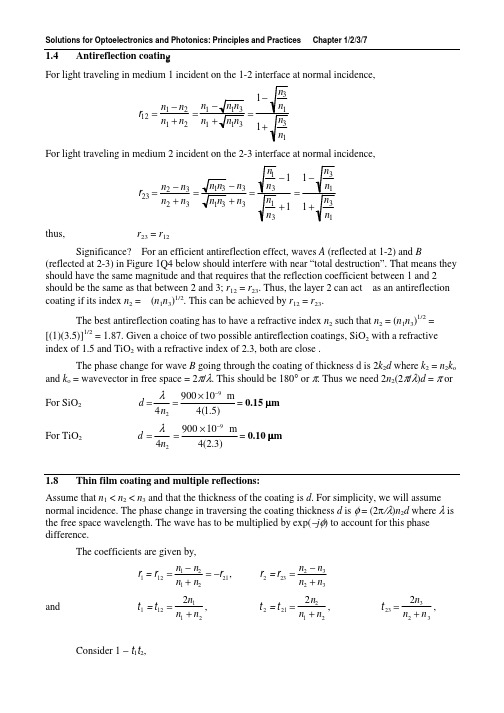
λ
4 n2
= =
900 × 10−9 m = 0.15 µm 4(1.5) 900 × 10−9 m = 0.10 µm 4(2.3)
λ
4n2
1.8
Thin film coating and multiple reflections:
Assume that n1 < n2 < n3 and that the thickness of the coating is d. For simplicity, we will assume normal incidence. The phase change in traversing the coating thickness d is φ = (2π/λ)n2d where λ is the free space wavelength. The wave has to be multiplied by exp(−jφ) to account for this phase difference. The coefficients are given by, n −n r1 = r12 = 1 2 = −r21 , n1 + n2 and
r12 =
n1 − n2 n1 − n1n3 = = n1 + n2 n1 + n1n3
1− 1+
n3 n1 n3 n1
For light traveling in medium 2 incident on the 2-3 interface at normal incid#43; n3
n1n3 − n3 = n1n3 + n3
n1 n −1 1 − 3 n3 n1 = n1 n +1 1 + 3 n3 n1
光电子材料与器件课后习题答案

3.在未加偏置电压的条件下,由于截流子的扩散运动,p 区和n 区之间的pn 结附近会形成没有电子和空穴分布的耗尽区。
在pn 结附近,由于没有电子和空穴,无法通过电子-空穴对的复合产生光辐射。
加上正向偏置电压,驱动电流通过器件时,p 区空穴向n 区扩散,在pn 结附近形成电子和空穴同时存在的区域。
电子和空穴在该区通过辐射复合,并辐射能量约为Eg 的光子,复合掉的电子和空穴由外电路产生的电流补充。
5要满足以下条件a 满足粒子数反转条件,即半导体材料的导带与价带的准费米能级之差不小于禁带宽度即B.满足阈值条件,半导体由于粒子数产生的增益需要能够补偿工作物质的吸收、散射造成的损耗,以及谐振腔两个反射面上的透射、衍射等原因产生的损耗。
即第二章课后习题1、工作物质、谐振腔、泵浦源2、粒子数反转分布5a.激光介质选择b.泵浦方式选择c 、冷却方式选择d 、腔结构的选择e 、模式的选择f 、整体结构的选择第三章课后习题10.要求:对正向入射光的插入损耗值越小越好,对反向反射光的隔离度值越大越好。
原理:这种光隔离器是由起偏器与检偏器以及旋转在它们之间的法拉第旋转器组成。
起偏器将输入光起偏在一定方向,当偏振光通过法拉第旋转器后其偏振方向将被旋转45度。
检偏器偏振方向正好与起偏器成45度,因而由法拉第旋转器出射的光很容易通过它。
当反射光回到隔离器时,首先经过起偏器的光是偏振方向与之一至的部分,随后这些这些光的偏振方向又被法拉第旋转器旋转45度,而且与入射光偏振方向的旋转在同一方向上,因而经过法拉第旋转器后的光其偏振方向与起偏器成90度,这样,反射光就被起偏器所隔离,而不能返回到入射光一端。
15.优点:A 、采用光纤耦合方向,其耦合效率高;纤芯走私小,使其易于达到高功率密度,这使得激光器具有低的阈值和高的转换效率。
B 、可采用单模工作方式,输出光束质量高、线宽窄。
C 、可具有高的比表面,因而散热好,只需简单风冷即可连续工作。
光电子学与光子学讲义-作业答案(第1、2章)13版
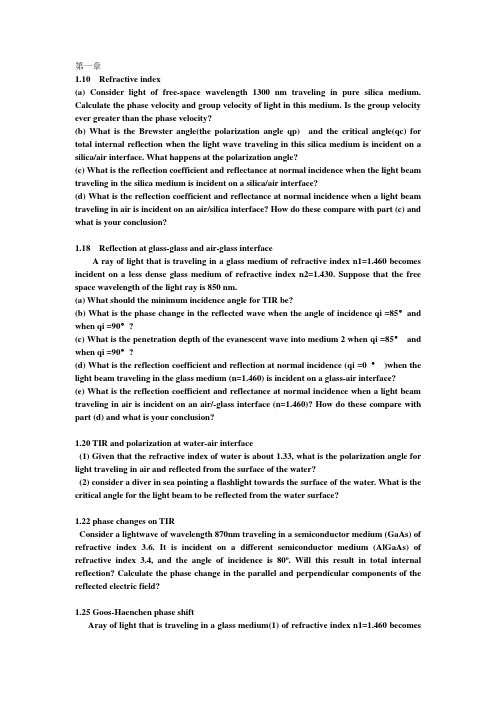
第一章1.10 Refractive index(a) Consider light of free-space wavelength 1300 nm traveling in pure silica medium. Calculate the phase velocity and group velocity of light in this medium. Is the group velocity ever greater than the phase velocity?(b) What is the Brewster angle(the polarization angle qp) and the critical angle(qc) for total internal reflection when the light wave traveling in this silica medium is incident on a silica/air interface. What happens at the polarization angle?(c) What is the reflection coefficient and reflectance at normal incidence when the light beam traveling in the silica medium is incident on a silica/air interface?(d) What is the reflection coefficient and reflectance at normal incidence when a light beam traveling in air is incident on an air/silica interface? How do these compare with part (c) and what is your conclusion?1.18 Reflection at glass-glass and air-glass interfaceA ray of light that is traveling in a glass medium of refractive index n1=1.460 becomes incident on a less dense glass medium of refractive index n2=1.430. Suppose that the free space wavelength of the light ray is 850 nm.(a) What should the minimum incidence angle for TIR be?(b) What is the phase change in the reflected wave when the angle of incidence qi =85°and when qi =90°?(c) What is the penetration depth of the evanescent wave into medium 2 when qi =85°and when qi =90°?(d) What is the reflection coefficient and reflection at normal incidence (qi =0 °)when the light beam traveling in the glass medium (n=1.460) is incident on a glass-air interface? (e) What is the reflection coefficient and reflectance at normal incidence when a light beam traveling in air is incident on an air/-glass interface (n=1.460)? How do these compare with part (d) and what is your conclusion?1.20 TIR and polarization at water-air interface(1) Given that the refractive index of water is about 1.33, what is the polarization angle for light traveling in air and reflected from the surface of the water?(2) consider a diver in sea pointing a flashlight towards the surface of the water. What is the critical angle for the light beam to be reflected from the water surface?1.22 phase changes on TIRConsider a lightwave of wavelength 870nm traveling in a semiconductor medium (GaAs) of refractive index 3.6. It is incident on a different semiconductor medium (AlGaAs) of refractive index 3.4, and the angle of incidence is 80o. Will this result in total internal reflection? Calculate the phase change in the parallel and perpendicular components of the reflected electric field?1.25 Goos-Haenchen phase shiftAray of light that is traveling in a glass medium(1) of refractive index n1=1.460 becomesincident on a less dense glass medium(2) of refractive index n2=1.430. Suppose that the free space wavelength of the light ray is 850nm.the angle of incidence θi =85°. Estimate the lateral Goos-Haenchen shift in the reflected wave for the perpendicular field component. Recalculate the Goos-Haenchen shift in the second medium has n2=1 (air). What is your conclusion?Assume that the virtual reflection occurs from a virtual plane in medium B at a distance d that is roughly the same as the penetration depth.Note that d actually depends on the polarization ,the direction of the field,but we will ignore this dependence.第二章 作业习题:θ2.7 Dielectric slab waveguide Consider a dielectric slab waveguide that has a thin GaAs layer of thickness 0.25μm between two AlGaAs layers. The refractive index of GaAs is3.6 and that of the AlGaAs layers is 3.40. What is the cut-off wavelength beyond which only a single mode can propagate in the waveguide, assuming that the refractive index does not vary greatly with the wavelength? If a radiation of wavelength 860 nm (corresponding to bandgap radiation) is propagating in the GaAs layer, what is the penetration of the evanescent wave into the AlGaAs layer? What is the mode field width (MFW) of this radiation? Point out the effect of change of radiation wavelength (λ) on the MFW.2.9 Dielectric slab waveguide Consider a planar dielectric waveguide with a core thickness 10μm , n 1=1.4446, n 2=1.4440. Calculate the V -number, the mode angle θm for m=0 (use a graphical solution, if necessary), penetration depth, and mode field distance (MFW=2α+2δ), for light wavelengths of 1.0μm and 5μm . What is your conclusion? Compare your MFW calculation with ()0221/a V V ω=+.The model angle θ0is given as θ0=88.85ᵒ for λ=1μm and θ0=88.72ᵒ for λ=1.5μm for the fundamental mode m=0.2.10 A multimode fibe r Consider a multimode fiber with a core diameter of 60μm , core refractive index of 1.47, and a cladding refractive index of 1.45 both at 870 nm. Consider operating this fiber at λ=870n m .(a) Calculate the numerical aperture.(b) Find out the normalized core-cladding index difference.(c) Calculate the V-number for the fiber and estimate the number of guided modes.(d) Calculate the wavelength beyond which the fiber becomes single-mode.(e) Calculate the modal dispersion τ∆and hence the bit rate ⨯distance product .2.12 Single mode fiber Consider a fiber with a 2SiO -13.5%2GeO core of diameter of 6m μ and refractive index of 1.47 and a cladding refractive index of 1.46 both refractive indices at 1300 nm where the fiber is to be operated using a laser source with a half maximum width (FWHM) of 2 nm..(a) Calculate the V -number for the fiver.(b)what is the maximum allowed diameter of the core that maintains oprations in single-mode?(c) Calculate the wavelength below which the fiber becomes multimode.(d) Calculate the numerical aperture.(e) Calculate the maximum acceptance angle.(f)Obtain the material dispersion and wavelength dispersion and hence estimate the bit rate⨯) of the fiber.⨯distance product (B L。
光电子学习题(1~5章)

第一章 思考与练习(答案)
7. 如果激光器分别以 = 10 m 和 = 0.5 m 输出 1 W 连续光功率,
试求这两种情况下,每秒钟从激光上能级向下能级跃迁的粒子数分别是多少?
解:
3 108 13 1 3 10 HZ 6 1 10 10 c
3 108 14 2 6 10 HZ 6 2 0.5 10 c
A21 称为爱因斯坦自发辐射系数,他的意义是在单位时间内, E2 能级上 n2 个粒子数中发生自发跃迁的粒子数与 n2 的比值;
为衰减因子;
v 为谱线宽度,表示原子发射的电磁场的衰减程度。 是指 g(v) 从最大值下降到一半时所对应的频率范围。 相互关系:
1 A21
A21
1
7. 如果激光器分别以 = 10m 和 = 0.5m 输出 1W 连续光功率,试求这两种情 况下,每秒钟从激光上能级向下能级跃迁的粒子数分别是多少?
第一章 思考与练习 8. 设一对激光能级 E2 和 E1(g2=g1),两能级间跃迁频率为(相应波长为),能 级上的粒子数密度分别为 n2 和 n1。试求: (1)当 =30 000MHz,T=300K 时,n2/n1 的值; (2)当 =1m,T=300K 时,n2/n1 的值;
N N 1 1 1 4 1 2 2 ( )2 ( N )2 2 ( N )2 2 N N 0 2 2 1 2 2 N 2 1 (1 6 19 ) g ( ) 2 g ( )
K 光视效率: V ( ) Km
v v 100 lm 0.293w m1 K ( ) Km V ( ) 683 lm / w 0.5
光电子学与光子学的原理及应用s.o.kasa 课后答案

1.4 Antireflection coating
For light traveling in medium 1 incident on the 1-2 interface at normal incidence,
For SiO2 For TiO2
d = λ = 900 × 10−9 m = 0.15 µm
4 n2
4(1.5)
d = λ = 900 × 10−9 m = 0.10 µm
4n2
4(2.3)
1.8 Thin film coating and multiple reflections:
Assume that n1 < n2 < n3 and that the thickness of the coating is d. For simplicity, we will assume normal incidence. The phase change in traversing the coating thickness d is φ = (2π/λ)n2d where λ is the free space wavelength. The wave has to be multiplied by exp(−jφ) to account for this phase difference.
The phase change for wave B going through the coating of thickness d is 2k2d where k2 = n2ko and ko = wavevector in free space = 2π/λ. This should be 180° or π. Thus we need 2n2(2π/λ)d = π or
光电子技术基础课后答案

光电⼦技术基础课后答案《光电⼦技术》参考答案第三章1.⼀纵向运⽤的 KD*P 电光调制器,长为 2cm ,折射率 n =2.5,⼯作频率为 1000kHz 。
试求此时光在晶体中的渡越时间及引起的相位延迟。
解:渡越时间为:L nL2.5 2 10c 2 m 1.671010sdc / n 310 m /s8在本题中光在晶体中的渡越引起的相位延迟量为:210 6Hz 1.6710101.051031m d对相位的影响在千分之⼀级别。
3.为了降低电光调制器的半波电压,采⽤ 4块 z 切割的 KD* P 晶体连接(光路串联,电路并联)成纵向串联式结构。
试问:(1)为了使 4块晶体的电光效应逐块叠加,各晶体 x 和 y 轴取向应如何?(2)若0.628m ,n 01.51,6323.6 10m /V ,计算其半波电压,并与单块晶体调制器⽐较之.。
12 答:⑴⽤与 x 轴或 y 轴成 45夹⾓(为 45°-z 切割)晶体,横向电光调制,沿 z 轴⽅向加电场,通光⽅向垂直于 z 轴,形成(光路串联,电路并联)的纵向串联式结构。
为消除双折射效应,采⽤“组合调制器”的结构予以补偿,将两块尺⼨、性能完全相同的晶体的光轴互成 90串联排列,即⼀块晶体的 y'和 z 轴分别与另⼀块晶体的 z 和 y'平⾏,形成⼀组调制器。
4块 z 切割的 KD P 晶体连接成*⼆组纵向串联式调制器。
(P96) (2)于是,通过四块晶体之后的总相位差为2 L Ld2n 3 or 63V 4 n 3 o r V 63 d相应的半波电压是1 d 1 r 63 L 4 1.51 0.628 10 6 m d 1V dLV0.77310 4 4 n o 33 23.6 10 12m /V L 4 0.19310 4 V dL 该半波电压是单块横向晶体调制器半波电压的四分之⼀倍,是单块纵向晶体调制器半波电压的 1/(2 L/d)倍。
一二三习题答案

(A)一种(B)两种(C)三种(D)四种
15.N2、O2、CO2、H2O和NH3,有红外吸收光谱的是H2O、NH3。
D16.红外光谱的基本振动区的波长范围一般在下列的哪一区间?
(A)10-10∽10-9m;(B)10-7∽2×10-7m;
(C)3×10-7∽6×10-7m;(D)2×10-4∽2.5×10-3cm
(C)分子处在基态(D)分子有两个自旋配对电子
C9.对于共价键联结的两个原子上的价电子分布,下列那种说法正确?
(A)均等(B)不均等(C)可均等也可不均等(D)无法判断
C10.下列哪种分子或离子键能最大?
(A)O2(B)O2-(C)O2+(D)O22-
B11.在HCl分子中,若以X为键轴,则成键分子轨道是由H原子的1s轨道和Cl原子下列的哪个轨道为主要成分组合而合成的?
(A)m=+1;(B)m=-1;(C)|m|=1;(D)m=0;
B4.若将N原子的基电子组态写成1s22s22px22py1违背了下列哪一条?
(A)Pauli原理;(B)Hund规则;(C)对称性一致的原则;(D)Bohr理论
A5.B原子的基态为1s22s2p1,其光谱项为下列的哪一个?
(A)2P;(B)1S;(C)2D;(D)3P;
D12.氢原子中的原子轨道有多少个?
(A)1个;(B)2个;(C)3个;(D)无穷多个
C13.对于原子的s轨道,下列哪种说法是正确的?
(A)距原子核最近;(B)必有成对电子;(C)球形对称;(D)具有方向性
A14.原子大小的数量级是下列的哪一个?
(A)10-8cm(B)10-18m(C)10-8m(D)10μm
- 1、下载文档前请自行甄别文档内容的完整性,平台不提供额外的编辑、内容补充、找答案等附加服务。
- 2、"仅部分预览"的文档,不可在线预览部分如存在完整性等问题,可反馈申请退款(可完整预览的文档不适用该条件!)。
- 3、如文档侵犯您的权益,请联系客服反馈,我们会尽快为您处理(人工客服工作时间:9:00-18:30)。
第一章1.10 Refractive index(a) Consider light of free-space wavelength 1300 nm traveling in pure silica medium. Calculate the phase velocity and group velocity of light in this medium. Is the group velocity ever greater than the phase velocity?(b) What is the Brewster angle(the polarization angle qp) and the critical angle(qc) for total internal reflection when the light wave traveling in this silica medium is incident on a silica/air interface. What happens at the polarization angle?(c) What is the reflection coefficient and reflectance at normal incidence when the light beam traveling in the silica medium is incident on a silica/air interface?(d) What is the reflection coefficient and reflectance at normal incidence when a light beam traveling in air is incident on an air/silica interface? How do these compare with part (c) and what is your conclusion?1.18 Reflection at glass-glass and air-glass interfaceA ray of light that is traveling in a glass medium of refractive index n1=1.460 becomes incident on a less dense glassmedium of refractive index n2=1.430. Suppose that the free space wavelength of the light ray is 850 nm.(a) What should the minimum incidence angle for TIR be?(b) What is the phase change in the reflected wave when the angle of incidence qi =85 ° and when qi =90° ?(c) What is the penetration depth of the evanescent wave into medium 2 when qi =85 ° and when qi =90° ?(d) What is the reflection coefficient and reflection at normal incidence (qi =0 ° )when thelight beam traveling in the glass medium (n=1.460) is incident on a glass-air interface?(e) What is the reflection coefficient and reflectance at normal incidence when a light beam traveling in air is incident on an air/-glass interface (n=1.460)? How do these compare with part (d) and what is your conclusion?1.20 TIR and polarization at water-air interface(1) Given that the refractive index of water is about 1.33, what is the polarization angle for light traveling in air and reflected from the surface of the water?(2) consider a diver in sea pointing a flashlight towards the surface of the water. What is the critical angle for the light beam to be reflected from the water surface?1.22 phase changes on TIRConsider a lightwave of wavelength 870nm traveling in a semiconductor medium (GaAs) of refractive index 3.6. It is incident on a different semiconductor medium (AIGaAs) of°. Will this result in total internal refractive index 3.4, and the angle of incidence is 80reflection? Calculate the phase change in the parallel and perpendicular components of the reflected electric field?1.25 Goos-Haenchen phase shiftAray of light that is traveling in a glass medium(1) of refractive index n1 =1.460 becomes incident on a less dense glass medium(2) of refractive index n2=1.430. Suppose that the free space wavelength of the light ray is 850nm.the angle of incidence(9=85 . Estimate the lateral Goos-Haenchen shift in the reflected wave for the perpendicular field component. Recalculate the Goos-Haenchen shift in the secondmedium has n2=1 (air). What is your conclusion?Assume that the virtual reflection occurs from a virtual plane in medium B at a distance d that is roughly the same as the penetration depth.Note that d actually depends on the polarization ,the direction of the field,but we will ignore this dependence.第二章作业习题:2.7Dielectric slab waveguide Consider a dielectric slab waveguide that has a thin GaAs layer of thickness 0.25 /w between two AIGaAs layers. The refractive index of GaAs is3.6 and that of the AIGaAs layers is 3.40. What is the cut-off wavelength beyond which only a single mode can propagate in the waveguide, assuming that the refractive index does not vary greatly with thewavelength? If a radiation of wavelength 860 nm (corresponding to bandgap radiation) is propagating in the GaAs layer, what is the penetration of the evanescent wave into the AIGaAs layer? What is the mode field width (MFW) of this radiation? Point out the effect of change of radiation wavelength (为on the MFW.2.9 Dielectric slab waveguide Consider a planar dielectric waveguide with a core thickness 10/m,ni=1.4446, n2=1.4440. Calculate the V -number, the mode angle 劣for m=0 (use a graphical solution, if necessary), penetration depth, and mode field distance (MFW=2 c(^2 9, for light wavelengths of 1.0 /xn and 5 /jn. What is your conclusion? Compare your MFW calculationwith 2»o =2a (V +1 )/V .The model angle 3is given as &=88.85?for ^=1 /m and ^=88.72 ?for ^=1.5 仰for the fundamental mode m=0.2.10 A multimode fibe r Consider a multimode fiber with a core diameter of 60 /m, core refractive index of 1.47, and a cladding refractive index of 1.45 both at 870 nm. Consider operating this fiber at ^=870nm.(e) Calculate the numerical aperture.(f) Find out the normalized core-cladding index difference.(g) Calculate the V-number for the fiber and estimate the number of guided modes.(h) Calculate the wavelength beyond which the fiber becomes single-mode.(i) Calculate the modal dispersion △ T and hence the bit rate x distance product.2.12 Single mode fiber Consider a fiber with a S1O2-13.5% GeOz core of diameter of 6 Wi and refractive index of 1.47 and a cladding refractive index of 1.46 both refractive indices at 1300 nm where the fiber is to be operated using a laser source with a half maximum width (FWHM) of 2 nm.. (j) Calculate the V -number for the fiver.(k) what is the maximum allowed diameter of the core that maintains oprations in single-mode?(l) Calculate the wavelength below which the fiber becomes multimode.(m) C alculate the numerical aperture.(n) Calculate the maximum acceptance angle.(o) Obtain the material dispersion and wavelength dispersion and hence estimate the bit rate x distance product ( B x L) of the fiber.。
